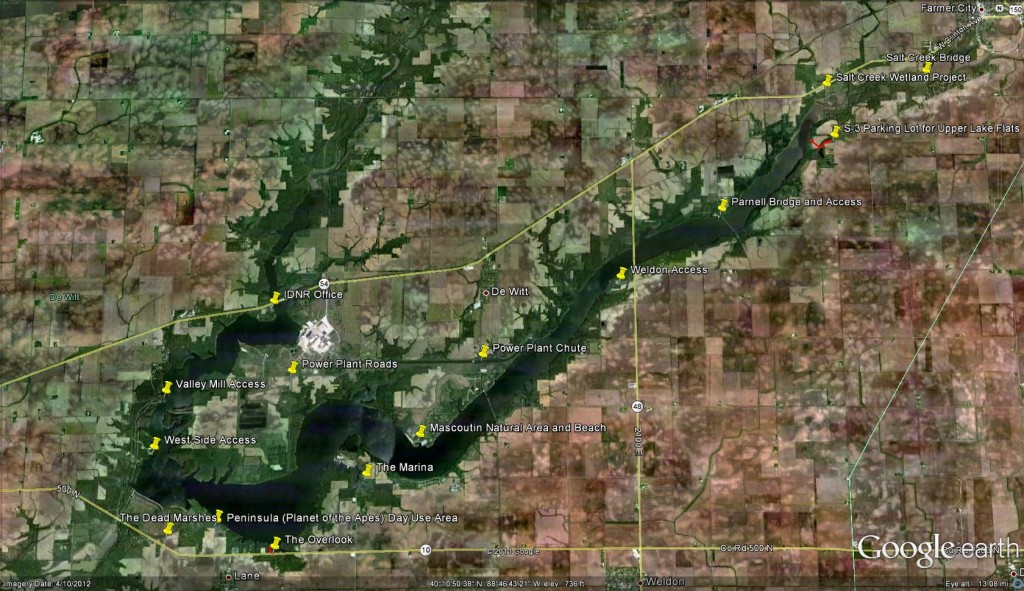Evergreen Lake, which is located in both McLean and Woodford Counties and the surrounding Comlara Park, is arguably the overall best location to find birds in McLean County, IL, boasting over 245 reported species, including such rarities as the only recorded Yellow-billed Loon in Illinois found in December 1998, Long-tailed Duck, Black Scoter, White-winged Scoter, Eared Grebe, Snowy Egret, Little Blue Heron, Cattle Egret, Whooping Crane, Franklin’s Gull, Glaucous Gull, Lesser Black-backed Gull, Harris’s Sparrow, and Western Kingbird. Older records include Golden Eagle, Western Willet, Hudsonian Godwit, Sanderling, Wilson’s Phalarope, Long-eared Owl, and Clay-colored sparrow (Michael Retter and Dale Birkenholz. http://www.xenospiza.com/McLean_Site_Guide.html).
Though not exceptionally large, the lake is 57 feet deep in places, which is deeper than Clinton Lake. Perhaps this is why that Yellow-billed Loon showed up for a Christmas Bird Count in 1998 (Michael Retter and Dale Birkenholz. http://www.xenospiza.com/McLean_Site_Guide.html).
Occasionally American White Pelicans in migration show up in large numbers here, but this is rare. In March 2011, there were up to 150 pelicans on the lake.
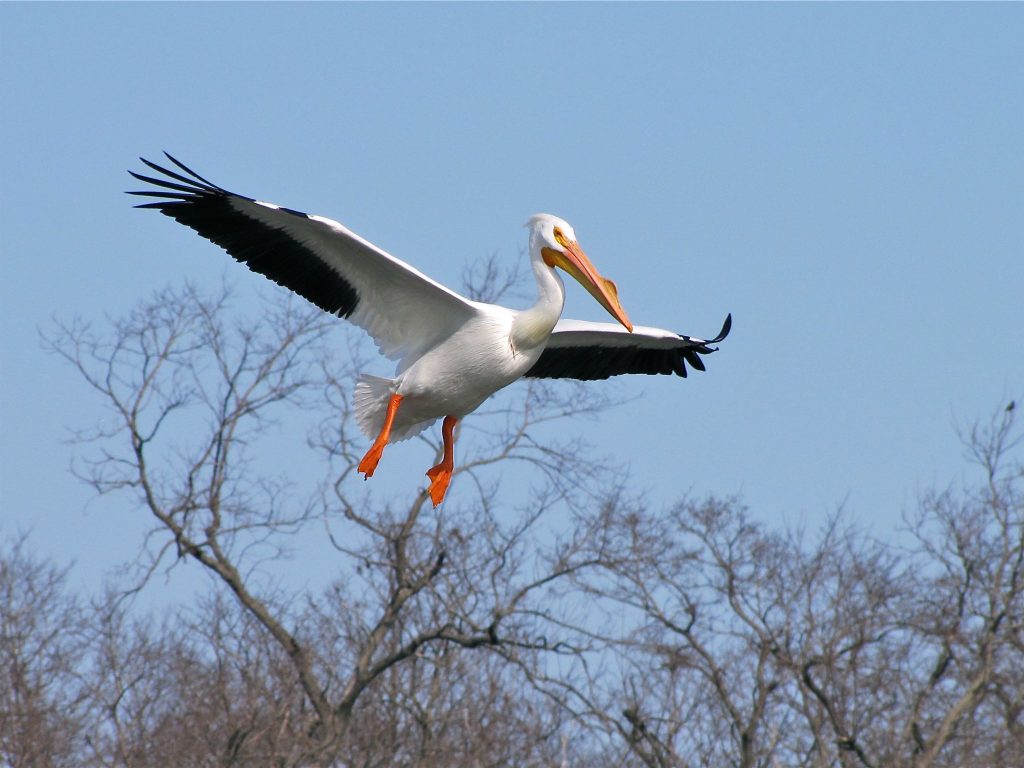
This map on the McLean County parks site, shows the location of all of the trails.
.
Hudson Grain Elevator
If you are looking for Eurasian Collared-Doves in McLean County, take Exit 5 off of I-39 and turn east on IL 12/Franklin St./County Rd 2200 N. Turn left on Shiner St., and you will see the grain elevator ahead.
The South End
Local birders refer to the area of the lake and park along E 2300 N Rd. in McLean County as the South End. To get to the South End, take Exit 5 off of I-39 and turn west on 12/Franklin St./County Rd 2200 N and go 1 mile. Turn right on North 1300 East Rd. As you are driving along N 1300 East Rd., keep your eyes out for Eastern Meadowlarks or blackbirds. Great Horned Owls hunt from the trees along this road at dusk. Also watch for Red-tailed Hawks and Northern Harriers in winter.
After about a mile, this road T’s into E 2300 North Rd. Eastern Bluebirds and Eastern Kingbirds can often be seen to the North at this intersection. Other birds seen near this intersection include a Loggerhead Shrike found in March 2015 and a Merlin in February 2017. Just before you reach this intersection, look to the left across the field on the west side of the road. You will see a small blind from which you can view a small wetland. To reach the wetland, drive to the T intersection and turn left. Then park in the parking area on the left in front of the outhouse. The Interpretive Trail, which begins west of the parking area will take you to the wetland. This trail is good for sparrows.
To the North of the intersection is the Barred Owl Trail, which takes you between a hedge of trees and a small prairie and then North into the woods. The prairie, the hedge, and the trail that goes through the woods are great for migrants in the spring and fall. The trail ends at the edge of the lake, and the end of the trail is an excellent place to view waterfowl, in winter, American White Pelicans in early spring, and Double Crested Cormorants during the summer, and shorebirds and waders in summer and fall when water levels are low. Several White-rumped Sandpipers were found here in early June 2011. In 2012, a Great Horned Owl nest across the lake to the North could be viewed from the end of this trail. The Shady Hollow Trail, just East of the intersection is great for migrants in the spring and fall.
If you turn east onto E 2300 North Rd. from the aforementioned intersection, you will come to a bridge that crosses the south end of the lake. This bridge is a great place to scan the lake with a scope or even from your vehicle. In winter and early spring, scan North and South of the bridge for waterfowl, waders, and grebes. Great Egrets can frequently be found here in April, August, and October. Sandhill Cranes were seen here in late February, 2017, a Little Blue Heron was seen south of the bridge in late July 2016, and a Least Bittern was seen here in late July, 2013. Look for breeding Green Herons and Great Blue Herons here in the summer months. In March and April, walk across the bridge and listen for Marsh Wren in the phragmites along the North side of the road. Listen for Sora and Virginia Rail late April and early May. In March/April and October/November, check the trees on either side of the bridge and to the East for congregating Rusty Blackbirds, and check the power-line along the bridge for swallows in the summer and early Fall. Also, in March and October, watch the sky over the lake and the treetops in the lake for Bald Eagles, Osprey, and other migrating raptors. The bridge is one of the two best locations on the lake to find shorebirds in late summer and fall when water levels are low. A Black-bellied Plover was seen here in September, 2011, and a Long-billed Dowitcher in October, 2011.
As you continue east, you will come to a parking pull off area on both sides of the road, and the John English Memorial Trail to the North. This trail winds 4.4 miles along the East side of the lake. Nesting White-eyed Vireos have been reported along the southern portion of the trail. The trail can also be accessed from the east side of the lake.
Just east of the John English Memorial Trail is a stream, which is good for Eastern Phoebe and other nesting birds, and east of the stream, is the John English Prairie. This prairie and the prairie to the South of the road on the Red Tail Trail are excellent for Sedge Wren in late July. Also, listen for nesting Blue Grosbeak in Red Tail Trail prairie to the south of E 2300 N Rd.
If you turn west onto E 2300 North Rd. from the aforementioned intersection, check the small stream you will cross for Brown Thrasher, Swamp Sparrows, and other migrants and nesters. You will see the Whitetail Slough Access Trail on your right to the North. Be careful parking in the small parking area west of the trail. It is easy to get stuck here when the parking area is wet and muddy. Hence the trail is appropriately named. The prairie can be good for Dickcissel all summer and Willow Flycatcher in early June. The area along the trail to the West of the prairie is good for sparrows in winter. A Harris’s Sparrow was found here on the Christmas Bird Count in 2015 and continued into January of 2016. If you continue north along the trail, past the prairie, you will cross over a stream on a small bridge and eventually come to another prairie, where Henslow’s Sparrows have nested. This prairie is also good for Eastern Meadowlarks and Dickcissels. In summer, look for breeding Yellow-billed Cuckoos, Baltimore Orioles, Northern Flickers, Yellow-breasted Chat, Barred Owls, and Turkey poults along this trail.
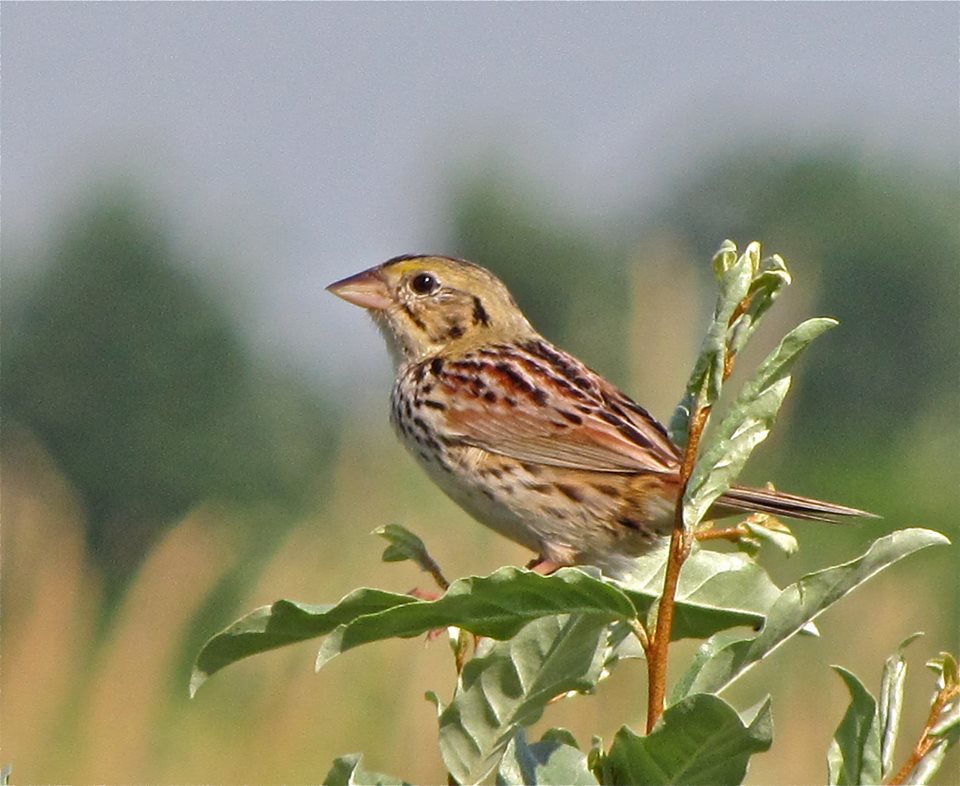
As you continue west along E 2300 North Rd., look for American Kestrels on the power lines. When you reach N 1200 East Rd., turn right and continue to the north to get to White Pines Trail and the west side boat access area.
White Pines Access Trail
To get to White Pines Access Trail from the south, take Exit 5 off of I-39 and turn west on IL 12/Franklin St./County Rd 2200 N and go 1 mile. Turn right (North) on North 1300 East Rd. Turn left onto E 2300 North Rd., go 1 mile, and turn right on N 1200 East Rd. You will pass a private pond on your left that can be good for Cackling and Greater White Fronted Geese. Then you will pass the Mallard Cove Access Trail and a section of the lake on you right just before you reach IL 8 to your left, and a gravel drive on your right. Pull into the gravel drive. To your left you will see an outhouse and a small cove section of the lake, and ahead of you, you will see a small handicapped ramp providing access to the lake. This cove can be good for waterfowl, waders, and even shorebirds in the fall when water levels are low. A Little Blue Heron was found on the North side of the cove in late July 2012, and two Whooping Cranes were seen flying northeast over the cove on March 28, 2013. The white pines on the east side of the cove can be good for Great Horned Owl and Golden Crowned Kinglet in winter. The prairie and savannah areas surrounding and to the South of the cove are good places to find White-throated, White-crowned, Song, and Swamp Sparrows, Baltimore Oriole, and Northern Harrier. Northern Shrike was seen several years ago in the Savannah area South of the cove as well as in the area Northwest of the intersection. If you hike the trail through the prairie/savannah area south of the gravel drive to the lake, you might flush a Wilson’s Snipe in late winter/early spring, and you might see Horned Grebes, Pied-billed Grebes, Common Loons, Red-breasted Mergansers, or other waterfowl in the lake from the trail. During appropriate times of the year, the cove can also be a good place to see gulls or swallows. Look for Eastern Meadowlark or American Kestrel on the power line at the Northwest corner of the IL 8/N 1200 East Rd. intersection.
West Side Boat Access
To get to get to the West Side Boat Access from the south, take Exit 5 off of I-39 and turn West on 12/Franklin St./County Rd 2200 N and go 1 mile. Turn right (North) on North 1300 East Rd. Turn left onto E 2300 North Rd., go 1 mile, and turn right on N 1200 East Rd.
From the North, take exit 8 off of I-39, and turn West on 8/E 2500 North Rd. Stay on this road for several miles as it winds North and then South around the dam and the west side of the lake. The road will turn east and finally run into N 1200 East Rd. Turn left onto N 1200 East Rd.
You will pass the White Pines Access Area on the east side of N 1200 East Rd. The next cove on your right is a great place to view waterfowl from the road or the adjacent pull-off just past it on your right beside the Meadow Lark Trail. Look for Green Heron here in late summer. Next, as you continue driving, check the cove on the left side of the road to the west.
The White Oak Primitive Camping Trail to the North of the Meadow Lark Trail is an excellent trail for Eastern Kingbirds and migrant songbirds, including vireos, thrushes, and warblers and for viewing waterfowl in the lake. In late February and early March 2013, this was one of two places from which 5 White-winged Scoters could be viewed for several days. Unfortunately, one of the scoters, an adult male, was found dead on this trail, from an injury attributed to a Bald Eagle attack.
Continue North on N 1200 East Rd. until the road dead ends. There will be a parking area to the left with an outhouse. Park here and walk to the west side of the parking lot to scan the Woodford County portions of the lake to the west. The west side of the parking lot can be a good place to see Common Loons in late March and early April. Once you have parked, you can walk along the boat access road to the east of the parking area toward the lake. In the cove east of the boat access road, look for Pied-billed Grebes, Buffleheads, and other waterfowl in March. To the North where the access road runs into the lake, look for Horned Grebes, Common Loons, Red-breasted Mergansers, and all kinds of waterfowl in February and March. This area north of the boat launch was where the five aforementioned White-winged Scoters were first located in late February 2013, and an Eared Grebe in breeding plumage with several Horned Grebes was found here in late March 2015. On November 1, 2016, a raft of 26 American Avocets was seen in the lake from the boat access road. It’s important to know that the parking area, and everything west of the road and the boat access road to the North is Woodford County. Everything to the East of the road and the boat access road is McLean County. On March 4, 2013, much of the lake was frozen, and a Glaucous Gull was found on the Woodford County side of the boat access. After several birders arrived and saw the gull, it flew east to the McLean County side of the boat access. So this spot can be a good place to get two county birds for the price of one, and this area of the lake can be good for gulls in late winter when most of the lake is frozen if there is some open water here.
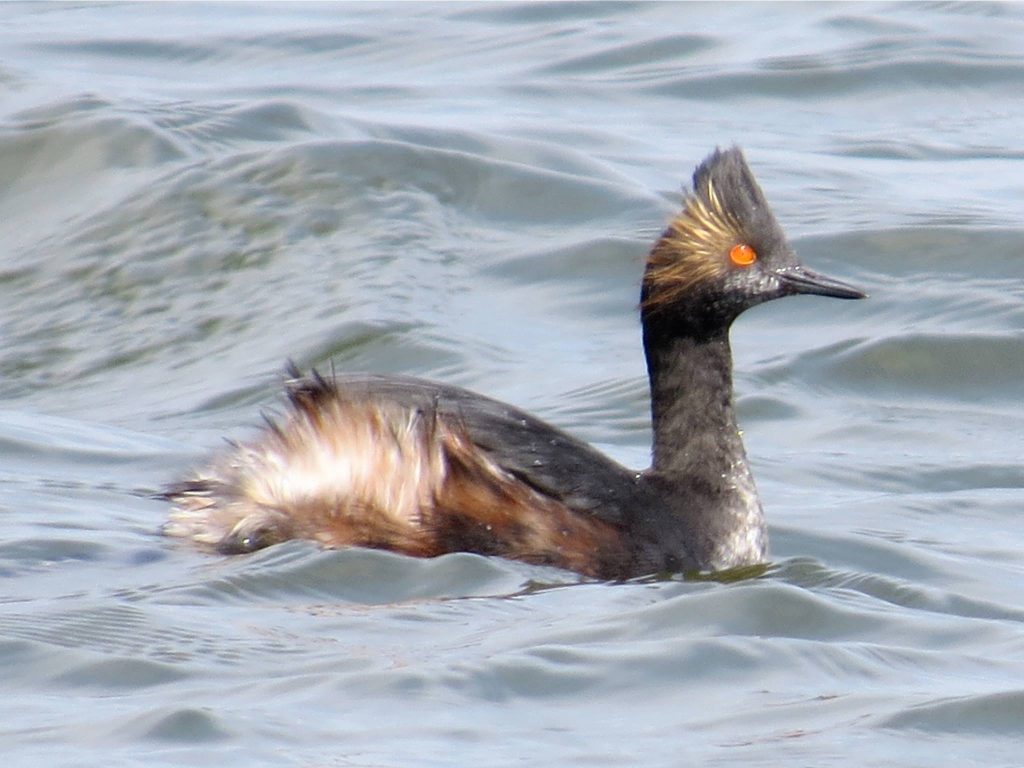
Biking Trails Trailhead
From the North, take exit 8 off of I-39, and turn west on 8/E 2500 North Rd. Stay on this road for several miles as it winds north and then southwest. You will go over the dam and then turn south. You will see a sign and a pull off on your left. These trails, all located in Woodford County can be good for Acadian Flycatcher in the summer and for other migrant and nesting birds.
The Dam and Spillway
The dam and spillway are in Woodford County. Take exit 8 off of I-39, and turn West on 8/E 2500 North Rd. Stay on this road for a couple of miles as it winds Northwest. You will cross the McLean/Woodford County line, and you will see a couple of pull-offs on the left side of the road from which you might be able to see gulls, Common Loons, or waterfowl. Just before and after you cross the county line, look for Barred Owl in winter after dawn or before dusk in the trees on the right side of the road. Listen and look for Blue Grosbeak in this area during the summer.
When the road turns southwest, you will be at the dam. The Big Flats Area Access Trail can be accessed from the east side of the dam. The dam and the Lake View Nature Trail adjacent to the lake and southwest of the dam are great places to see Common Loons, gulls, Red-breasted Mergansers, and other waterfowl. Lesser Black-backed Gull was seen here on the ice in March 2013, and a White-winged Scoter remained in the lake south of the dam for several days in late March and early April 2014. Four Trumpeter Swans were seen from the dam for several days in January 2013.
The Bovine and Hillside Trails northwest of the dam are excellent for warblers, cuckoos, and other migrants in migration. These trails also lead down into the spillway, where waders and shorebirds can be found in spring, summer, and fall. For another chance to see Barred Owl in winter, continue southwest on 8/E 2500 North Rd., past the dam, and look in the pines on the left side of the road after dawn or just before dusk.
The Water Pump House
Take exit 8 off of I-39, and turn west on 8/E 2500 North Rd. You will pass the Comlara Park sign and the campground on your left. Continue on 8/E 2500 North Rd. until you see a pull-off parking area with a fence and a building behind the fence. Park in the parking area, walk past the fence. Look for waders and Song Sparrows to the right of the fence. Walk to the building and scan the lake from either side of the building. When the lake almost completely freezes, there is only open water here around the water pump house. Sometimes, gulls, Snow Geese, and Greater White-fronted Geese gather on the ice around the open water in winter, and a variety of ducks can be found here when the rest of the lake is frozen. A pair of Trumpeter Swans was seen here in February 2015. A Long-tailed Duck and two White-winged Scoters were found here in February 2014 along with American Black Duck, American Wigeon, Red-breasted Merganser, and several more common species. Twenty-two Tundra Swans were seen from the water pump house on January 26, 2012. A Ross’s Goose frequented the open water here in March 2014. Redheads and Canvasbacks are often found here in February. Look for Forster’s Tern on the buoys in the lake by the water pump house in late July and early August, and look for Caspian Terns flying over the area from late July through early September. Watch for Bald Eagles on the ice December through February when the lake is frozen and Bald Eagles and Osprey flying over, especially in March and October. Waterfowl can also be viewed from the trail west of the water pump house, and Common Loons, gulls, and Red-breasted Mergansers can sometimes be seen from the pull-offs further west on 8/E 2500 North Rd. There are red cedars east of the water pump house. A Northern Saw-whet Owl was found in one of these cedars a few years ago. Barred Owls can sometimes be heard or seen in the yards east of the water pump house at dusk.
Exit 8 Borrow Pit
Take exit 8 off of I-39. Turn west on 8/E 2500 North Rd. You will see a borrow pit on the left side of the road. Do not pull into the gravel drive since the borrow pit is on private property. Pull off on the side of the road and scan the pit from the road. Look for geese behind the pit or ducks swimming in the pit. Two Ross’s Geese were found here in March 2013, and Snow Geese, Greater White-fronted Geese, Redheads, Canvasbacks, Ring-necked Ducks, scaups, and Northern Shovelers have been seen here as well. The area around the pit is also good for Eastern Meadowlark and blackbirds, and swallows in early spring.
Comlara Park
Take exit 8 off of I-39. Turn west on 8/E 2500 North Rd. After you pass the borrow pit on your left, watch for raptors on both sides of the road. This area has yielded both Northern and Western Red-tailed Hawks in early 2017.
You will soon see a Comlara Park sign on your left. Turn left here on 33/Comlara Park Rd. As you are turning and begin to drive south, watch the pines on your right for Barred Owl early in the morning or just before dusk. Watch also for other raptors. An adult Red-shouldered Hawk was seen along this road in March 2013. You will soon see another sign for Comlara Park on your right. Turn at this sign onto Recreation Area Dr. On your left, you will see the park office, which is a good place to stop and watch the feeders. Look the feeders here and the trees behind them for Tufted Titmouse, Black-capped Chickadee, Red-bellied Woodpecker, Downy Woodpecker, Northern Cardinal, White-breasted Nuthatch, and even Red-breasted Nuthatches in irruptive years. Watch the ground beneath the feeders for all kinds of sparrows.
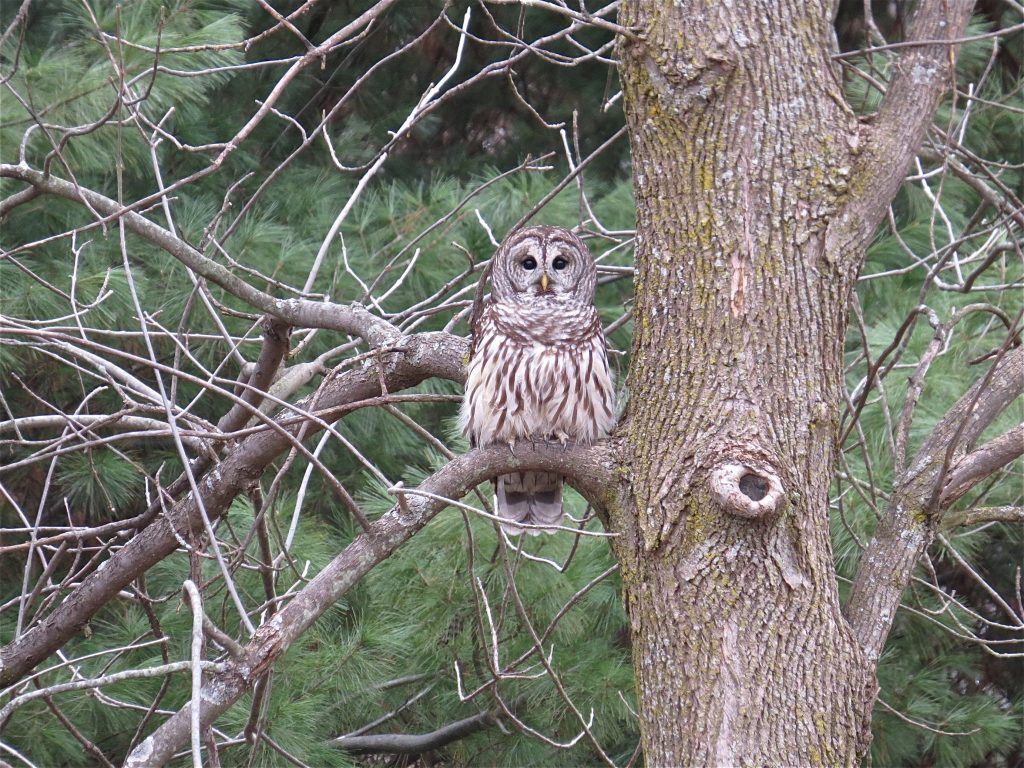
Turn right again here on Campground Ln. to get to the campground to the North. In past years, American Woodcocks displayed along Campground Ln. If the gate is open, drive north onto the bridge and watch the lake for Common Loons, grebes, and waterfowl. Look around the water to the right of the bridge for Spotted Sandpiper in early spring, and watch the skies for Osprey in April or October.
Return to Recreation Area Dr. and continue southwest. In 2013, a Great Horned Owl pair nested in one of the trees southwest of the campground on Recreation Area Dr. As you continue southwest along Recreation Area Dr., there will be a pull-off next to a roofed picnic structure on your left. Pull off here and walk straight ahead east down the hill to the lake. This is usually the best areas to view gulls and a variety waterfowl once the lake has thawed in February or March. Great Egrets can sometimes be seen perched in the trees across the lake. A Snowy Egret was seen on the opposite shore from here on October 18, 2016.
Continue Southwest on Recreation Area Dr. Turn into the road to the right and you will discover more areas to view waterfowl on the west side of the Comlara Park peninsula. An Eared Grebe was found on the west side of the peninsula in 2012. The trees along the edges of the lake here can be good for warblers and other migrants in the spring and fall. Look for Eastern Bluebirds in the trees on the right side of Recreation Area Dr. as you continue southwest toward the large gravel parking area. Drive into the parking area, continuing southwest until you reach the east side boat access. From here, you can view the lake to the east of the Comlara Park peninsula. This area can also be very good for waterfowl. Three Tundra Swans were seen on the ice here in December, 2016. Orchard Orioles have nested in the trees south of the parking area. There is also a beach on the southwest side of the parking area, which can be good for gulls and shorebirds in migration.
Deer Island Area
Take exit 8 off of I-39. Turn west on 8/E 2500 North Rd. After you pass the borrow pit on your left, you will see a Comlara Park sign on your left. Turn left here on 33/Comlara Park Rd. You will see another sign for Comlara Park on your right, but instead of turning right, continue to go straight, heading south. As you pass the sign on your right, watch for Barred Owl on your right just before dusk. Also watch for Osprey in March. There is an Osprey platform along the John English Memorial Trail to your left. Continue south until you can view the lake to the west. Then pull off the road to your right to view waterfowl, Ring-billed and Herring Gulls in winter and Double-crested Cormorants and waders in spring and summer. This area of the lake can be good for Trumpeter Swans in November and February when the lake is not frozen. It can also be good for Bonaparte’s Gulls from late October through early November. When the water levels are really low in late summer through October, there can be some mudflat here for shorebirds such as Dunlin, Stilt Sandpiper, and Black-bellied Plover. Two Black Terns were seen here on the mudflat in August 2012. As you continue on 33/Comlara Park Rd. south, watch the trees for Rusty Blackbirds congregating in late March and early April.
Pull off a little further down and look southwest to the peninsula across the lake. When the water levels are low in late summer and fall, there is a sandbar or spit here that has hosted Caspian Terns, Ring-billed and Bonaparte’s Gulls, and even hosted a Franklin’s Gull on October 26, 2013. This spit can also be good for shorebirds and American Pipits.
As you continue South, Comlara Park Rd. will T into a pull-off to the west and E 2400 North Rd to the east. During spring and summer, check the fence on the east side of the road here. A Western Kingbird was found on this fence on May 14, 2014.
Park in the pull off to your right where the road T’s. Hike west through the hedge down the hill to the John English Memorial Trail. This section of the John English Memorial Trail is known to local birders as the Deer Island Trail. Deer Island is the large island that you can see across the lake to the west from Comlara Park Rd. Turn left onto the Deer Island Trail and head south. In mid to late April and early May, watch and listen as you walk by the reeds for Wilson’s Snipe, Marsh Wren, Sora, Virginia Rail, American Bittern, Yellow Warbler, Great Blue Heron, Pied-billed Grebe, and Blue-winged Teal. One evening on April 25, 2013, Virginia Rail, Sora, Marsh Wren, Prairie Warbler, and a flyover Sandhill Crane were all seen along this trail. This trail is also good for sparrows throughout the year. Some of these birds can also be seen or heard at times walking north on this trail toward the Osprey platform.
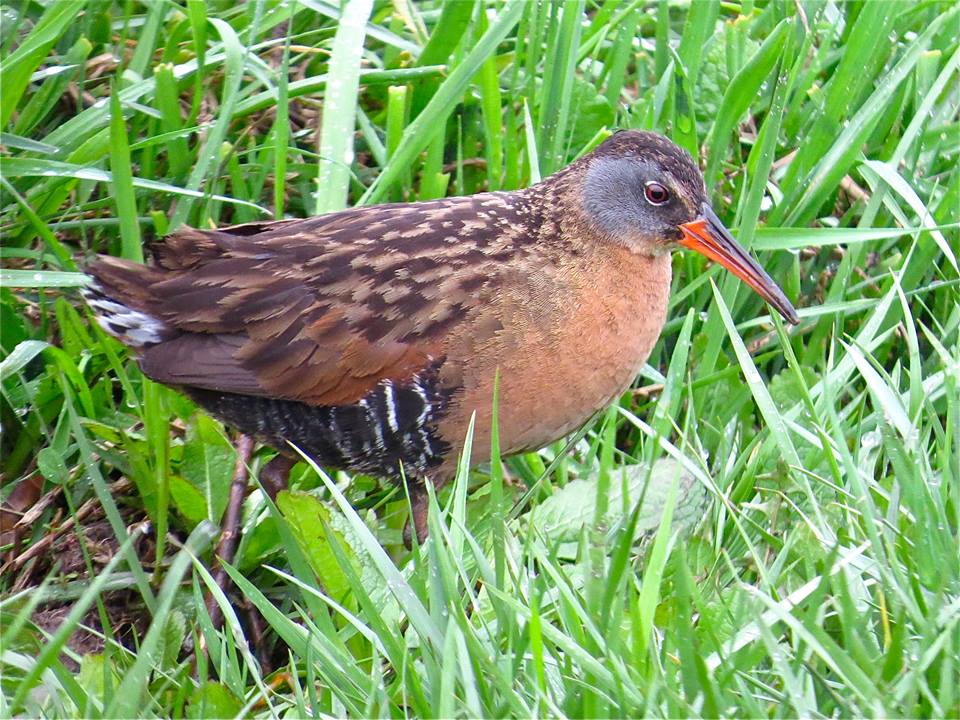
However, as you continue walking south, the trail will split, toward the west and the south. Go west, and you will cross a bridge and turn north to circle the inside of the peninsula. This trail will lead you North between a prairie and a hedge of trees to the aforementioned sandbar or spit. As you turn west, cross the little bridge, and then turn north, listen and watch for Hairy Woodpecker as well as for all kinds of migrant songbirds and nesting birds such as Rusty Blackbird, Gray Catbird, Baltimore Oriole, Orchard Oriole, Field Sparrow, Brown Thrasher, Common Yellowthroat, and Yellow-breasted Chat. When you are able to see the lake to your right through the vegetation and water levels are low, you will see the spit and be able to get a closer look at any gulls, waders, or shorebirds on it through the vegetation, if you have a scope, or a camera with a good zoom lens. Approach slowly as the birds on the sandbar can be easily spooked. Also, scan the shore for Swamp Sparrows year round and for American Pipits in late October or early November.
Take E 2400 North Rd. East. Watch the trees on the left side of the road for Brewer’s Blackbirds in December and for Northern Harriers and other raptors in winter. Check the prairie on the left side of the road for sparrows and Orange-crowned Warblers in the fall. Turn north on N 1350 East Rd. and continue to watch the fields for raptors. This road will take you back to 8 E 2500 North Rd. on the west side of the borrow pit.
